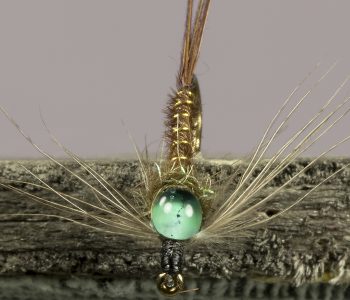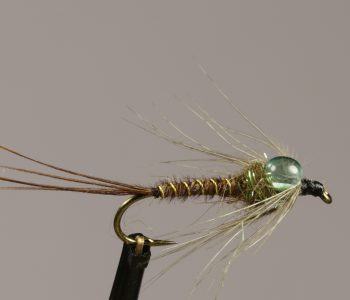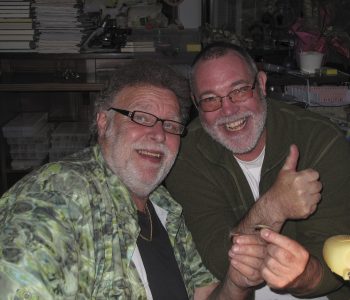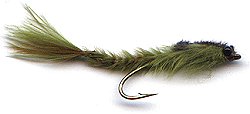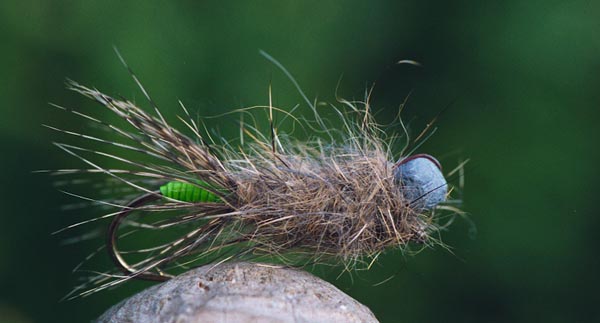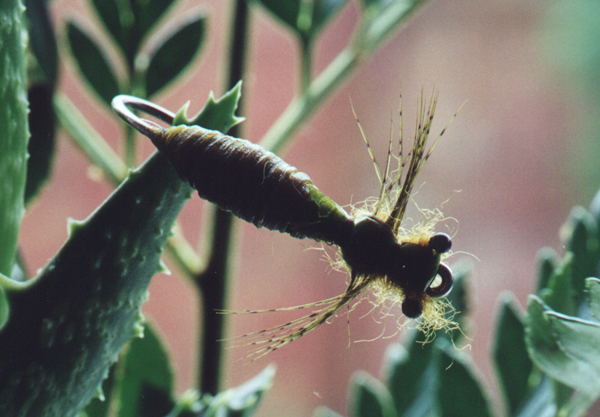
Gold Balls & Silver Bullets
Originally designed for the large, deep and fast flowing rivers of Scandinavia, the beadheads are also very effective patterns for any other watercourse. Their value has been noticed by a growing number of fly fishers, and they are accounting for some good fish, whether in running or still water. I must confess though that as effective as they are, my passion is fishing the dry fly for trout in wild rivers. Deep fishing the nymphs fails to invoke anything like the pleasure I get when I incite a fish to rise to my fly. However, as much as I prefer the dry fly, there are times when only the use of deeply fished nymphs will bring any hope of a reaction from the trout or grayling. The worst scenario for the dry fly fisher is when the fish are feeding in deep lies, and under such circumstances, these fast sinking patterns are often the only recipe for success.
Contrary to current thinking, the gold headed nymphs have been around for a very long time. In early nineties, several European fishing magazines have published articles on all kinds of gold bead patterns. Swedish fly fishers have been using them since the early ’70s, and elsewhere, even much earlier. Thanks to the efforts of Roman Moser from Austria, and the skillful Dutch angler and fly tyer, Theo Bakelaar, the golden headed flies were reborn in the late eighties again. Theo, now better known as “Mr. Goldhead,” has probably the largest collection of gold headed flies in the world, and introduced them in the USA. Well, I, too, have made several experiments with gold and silver beaded flies over the years, and I shall describe some of my most successful patterns later in this article.
THE POWER OF GOLD
I think the effectiveness of gold and silver beads at the head of a fly, stems from a number of main functions. First, it weights the fly, getting it down quickly to where the fish are feeding. In addition, you also get a longer drift through the level of feeding fish. Secondly, though I don’t know whether fish see the gold bead as we do, I feel that some fish are attracted to its golden sparkle and glitter. I am sure that I have caught some nice fish because of this glitter. I also caught a lot of fish in brackish water on these patters, when all other patterns failed. Possibly the fish perceive it as the little bubbles of air that cling to pupae or mature nymphs when they rise to the surface. Thirdly, the weighting at the head of the fly gives it a particular action, when drawn through the water. I am sure that this action is significant when these patterns are used in still water. Finally, I discovered that sight fishing is very easy with these types of patterns. Anyone who fishes crystal clear water will find the shiny beads a boon. The shiny head can be easily seen twinkling down, and when it disappears, more often then not, you will have a very surprised trout on the end.
DULL OR BRIGHT: GOLD OR SILVER
I only use gold plated brass beads that will not tarnish. I know several other successful anglers, however, who use plain brass beads, and some really great fly fishers who actually prefer dull beads to shiny ones! I can’t say for certain which are the best, but for me, personally, I prefer the bright ones. You will have to experiment for yourself, and draw your own conclusions. The choice between gold, black, cupper or even silver beads is something totally different. It depends on the kind of river or lake you are fishing in, and on the water conditions. In some rivers, one will have excellent results with goldheads, while on other streams, the silver version is more successful. There is certainly little need to be faithful to any particular dressing where beadheads are concerned, and I suggest that you convert some of your own favorite patterns to beadheads and see what happens.
FEEDING MEMORY (be warned)
Although many people think about it differently, I strongly believe in feeding memory of fish. Fish know the differences well and I prove that to myself and to others many times. With gold, silver or cupper beaded patterns the success can be enormously but this success doesn’t last forever. One of the most striking tests we ever did happen in the mighty Glomma River in Norway were we only fish for wild fish. In the early nineties one of our fishing groups discovered one of the most successful fishing spots we had ever seen so far and the catches broke all earlier records. Trout, grayling and whitefish went totally mad. The flies they using were gold and silver beads. The success only last for 3 days! The fish was still there but refuse to take any beadheaded fly that came to water. Only with very realistic fly imitations we could succeed and that set you thinking.
Here are a few of my most successful bead headed patterns that you might care to try.
THE GOLDHEAD

Hook: Daiichi 1260, 1280, 1710 sizes 10 and 12
Head: Gold-plated brass bead.
Thread: Uni-thread 8/0 brown
Tag: Four turns of a fluorescent green material
Body: Dubbed rabbit fur, with plenty of guard hairs well picked out.
Tail: A large brown partridge hackle, wound just in front of the tag. It is important that the fibers are positioned so as to leave the tag well visible from the sides.
THE SILVER CADDIS

Hook:Daiichi 1260, 1280, 1710 sizes 10 and 12
Thread: Uni-thread 8/0 gray
Thorax: A silver bead
Body: Dubbed rabbit fur, with plenty of guard hairs well picked out.
Hackle: Large brown partridge hackle, stripped off on one side, tied in at the tip and wound as a collar hackle just in front of the bead
THE GOLDEN DIVER

Hook:Daiichi 1260, 1280, 1710 sizes 10 and 12
Thread: Uni thread 8/0 gray
Head: A gold plated brass bead
Body: Golden yellow dubbing like haretron or substitute
Rib: Copper wire
Wing: White antron yarn or Organza fibers
Thorax: Gray hare-tron, wound over the yellow dubbing
THE GOLDEN SPIDER

Hook:Daiichi 1260, 1280, 1710 sizes 10 and 12
Thread: Uni-thread 8/0 black
Head: A gold plated brass bead
Thorax: Peacock herl
Body: Five strands of yellow or pearl Crystal Flash, tied as a nicely tapered body.
Hackle: Brown partridge feather, stripped off on one side, tied in by the tip between the body and thorax
THE BLACK AND SILVER NYMPH

Hook:Daiichi 1260, 1280, 1710 sizes 10 and 12
Thread: Uni-thread 8/0 black
Head: A silver plated brass bead
Tail: Dyed black pheasant tail fibers
Rib: Red copper wire
Body: Five herls of a black feather.
Thorax: Peacock herl, or a mixture of black sparkle yarn and spectraflash, dubbed and well picked out.
TYING TECHNIQUE
Goldhead

Step 1
Put the bead on the hook. Wrap some tying thread in front of the bead, and push the bead as close to the hook eye as possible. Secure the bead by wrapping some thread behind it.
Step 2
Tie in a tag of green fluorescent material, and wrap it with four windings on the hook shank. Tie in the partridge hackle, and wind it as collar in front of the tag.
Step 3
Put on some dubbing, and wind a nice body. Pick the dubbing out well, after the fly has been tied off.


